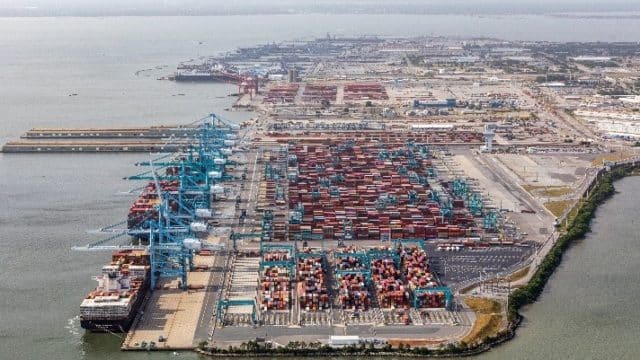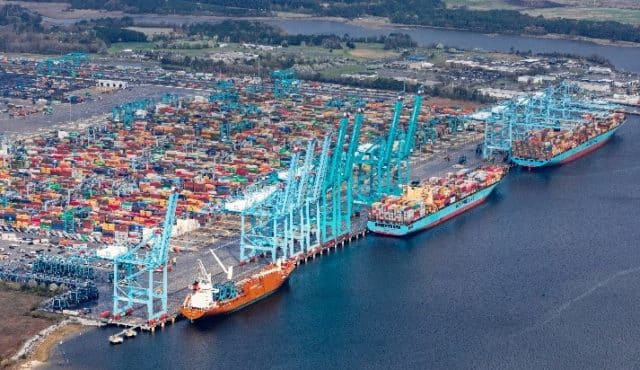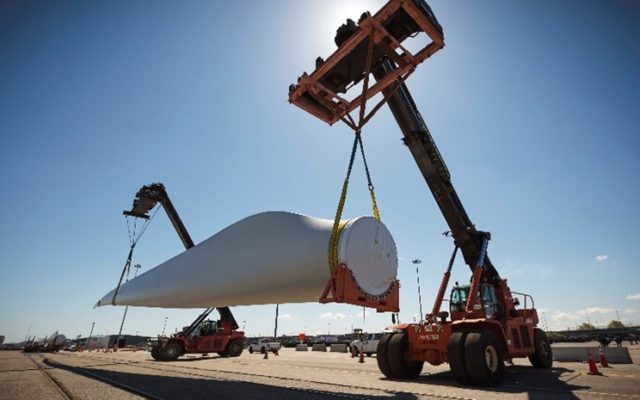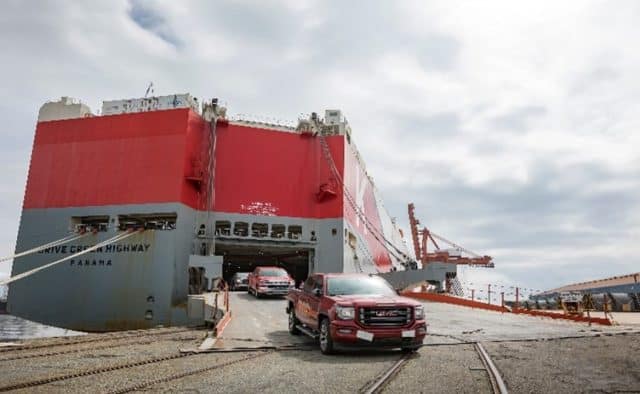The global economy is highly dependent upon waterways for moving goods. America’s maritime transportation infrastructure includes approximately 25,000 miles of navigable channels, 250 locks, and 3,500 marine terminals, which connect to a vast network of rail, highways, and intermodal facilities. Waterborne cargo and associated activity contributes more than $500 billion dollars to the U.S. GDP, generates over $200 billion in annual port sector federal/state/local taxes, and sustains over 10 million jobs.[1]
CATEGORIES OF WATERBORNE CARGO
The U.S. Department of Transportation’s Bureau of Transportation Statistics (BTS) classifies waterborne cargo into five major categories: containerized, dry bulk, liquid bulk, break bulk, and roll-on/roll-off (Ro/Ro).[2] The infrastructure and equipment available at each port determine which types of waterborne cargo can be handled at the port. Some ports specialize in a single type of cargo, whereas others handle multiple types of cargo. BTS reports annually on the top 25 maritime ports in terms of overall cargo tonnage, dry bulk cargo tonnage, and containerized cargo. In 2020, five ports ranked in the top 25 on all three measures: Baltimore, Houston, Mobile, New Orleans, and Virginia.[3]
Containerized shipping has taken center stage with recent demands on the supply chain. Nearly all consumer products are now transported in a standardized steel box transported by container vessels. Container terminals across the world have been preparing to handle containerized cargo that is being loaded / unloaded from ultra large container vessels (ULCV). Recently, ports along the East Coast welcomed the CMA CGM Marco Polo, the largest ULCV yet to call at 16,022 TEUs (twenty-foot equivalent units). With the large fluxes of cargo being unloaded from these vessels, it is important for terminal operators to have a free flowing port with quick gate turn times, automation, and reservation systems.
Two terminals that have recently been modernized and expanded to handle these mega vessels include Norfolk International Terminals (NIT) and Virginia International Gateway (VIG). The Port of Virginia doubled its annual container capacity at its deep water terminals and now has the largest ship to shore cranes in the Western Hemisphere working on its berth. In total, The Port of Virginia has added capacity of over 1 million containers due to the expansion project at VIG and the terminal optimization at NIT.


To efficiently move the increasing amounts of cargo that these ULCVs are bringing, the inland terminal option has grown in popularity. Inland terminals offer the ability to provide the same level of service to businesses located near the deep water serviced ports. Shipping containers are loaded / unloaded from the vessel, transferred to the rail or barge, and then loaded or unloaded at the final destination. Distribution is often made more efficient and sustainable by inland terminals being located closer to the end user or along a major interstate artery.
When a shipper has cargo that can’t fit into a container they have to utilize a specialized vessel and terminal to transport the goods. Break bulk is often heavy and requires special crane lift capabilities. Roll-on/Roll-off (Ro/Ro) is a type of break bulk cargo that is able to be rolled on/off the vessel without the need for cranes. Examples of these types of cargo include steel rolls, wind turbines, heavy machinery, and vehicles. Virginia boasts two terminals that are well equipped to handle these types of cargo: Portsmouth Marine Terminal (PMT) and Newport News Marine Terminal (NNMT).


Dry bulk tonnage is comprised of commodities such as grain, coal, and iron ore. Due to the concentration of farming in the Midwest, many ports along the Great Lakes and Mississippi River have dry bulk vessels as their dominant vessel type.[2] The Port of Virginia, although diversified in the type of cargo handled, ranked #4 in 2020 for dry bulk cargo.[3] Liquid bulk terminals are located near pipeline connections and/or refineries, including many along the Gulf of Mexico, and handle products including petroleum and chemicals.
PORT CONSIDERATIONS IN THE SITE SELECTION PROCESS
Projects that may utilize port(s) should take into consideration both the initial needs of the project and potential future elements during the site selection process. An experienced site selector and/or port governance entities can assist in assessing the infrastructure, equipment, and available capacity to determine potential solutions.
Port partners also offer a number of tools that help to make doing business easier. For example, the Port of Virginia’s Port Centric Logistics team provides a full complement of services to assist existing and prospective shippers that include but are not limited to tax credits, grant programs, Foreign Trade Zone (FTZ), vessel schedules, turn time comparisons, and rate quotes.
TERMINAL SOLUTIONS FOR FUTURE GROWTH
Support for maritime infrastructure at the federal, state, and local level are critical to the supply chain. The Maritime Administration’s (MARAD) Port Infrastructure Development Program (PIDP) is focused on improving ports’ capacity and infrastructure. In December 2021, the federal government announced more than $241 million in discretionary grant funding for 25 projects to improve port facilities, including coastal seaports, Great Lakes ports, and inland river ports.[4] Among the recipients is the Portsmouth Marine Terminal Offshore Wind Development in Portsmouth, VA which will use the funding to support offshore wind projects.
1 https://www.maritime.dot.gov/outreach/maritime-transportation-system-mts/maritime-transportation-system-mts
2 https://data.bts.gov/stories/s/Types-of-Ports/tb7x-7n7g
3 https://doi.org/10.21949/1524417 2022 Port Performance Freight Statistics Program: Supply-Chain Feature (Washington, DC: 2022)
4 https://www.maritime.dot.gov/newsroom/press-releases/us-transportation-secretary-pete-buttigieg-announces-over-241-million
Laura Swankler currently serves as Senior Manager of Port Centric Logistics at The Port of Virginia. She oversees The Port of Virginia Foreign Trade Zone Grant of Authority and manages economic development territories throughout the Commonwealth. During her time at the Port, she has helped to facilitate the creation of new jobs and capital investment through the successful recruitment and expansion of port-related activity. Laura can be reached at lswankler@portofvirginia.com.
In 2021, CNBC ranked Virginia as the #1 state for business, and The Port of Virginia plays a key role in Virginia’s ability to serve those businesses. The Port of Virginia is doing everything necessary to become the U.S. East Coast’s leading gateway for global trade for the next several decades, and to make Virginia the #1 place for businesses in the country. https://www.portofvirginia.com/